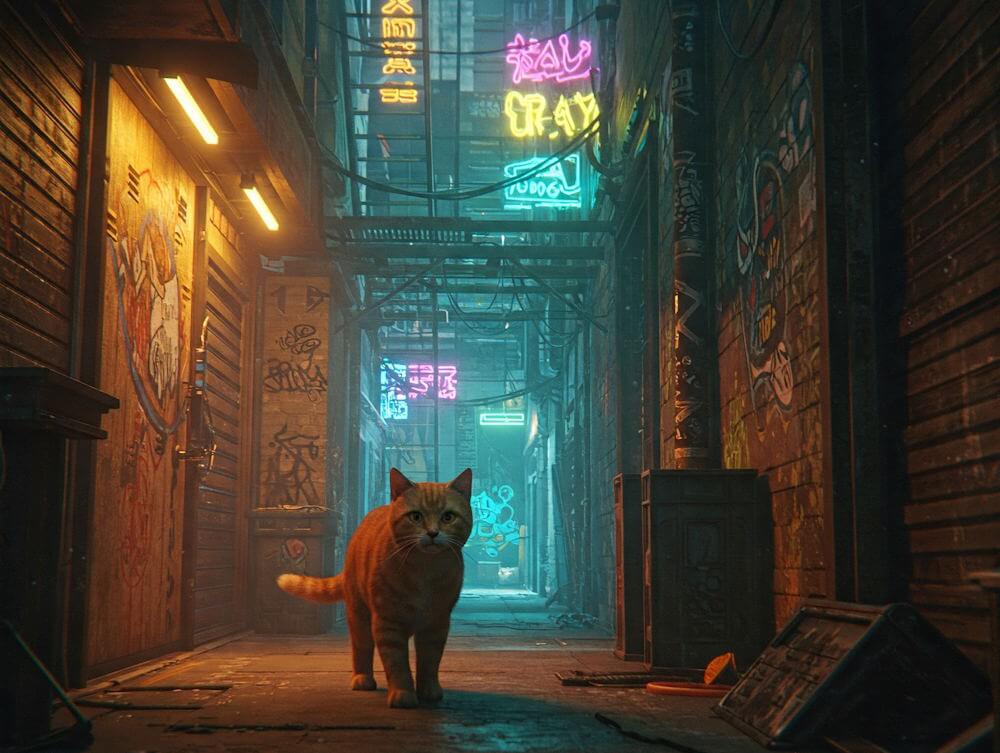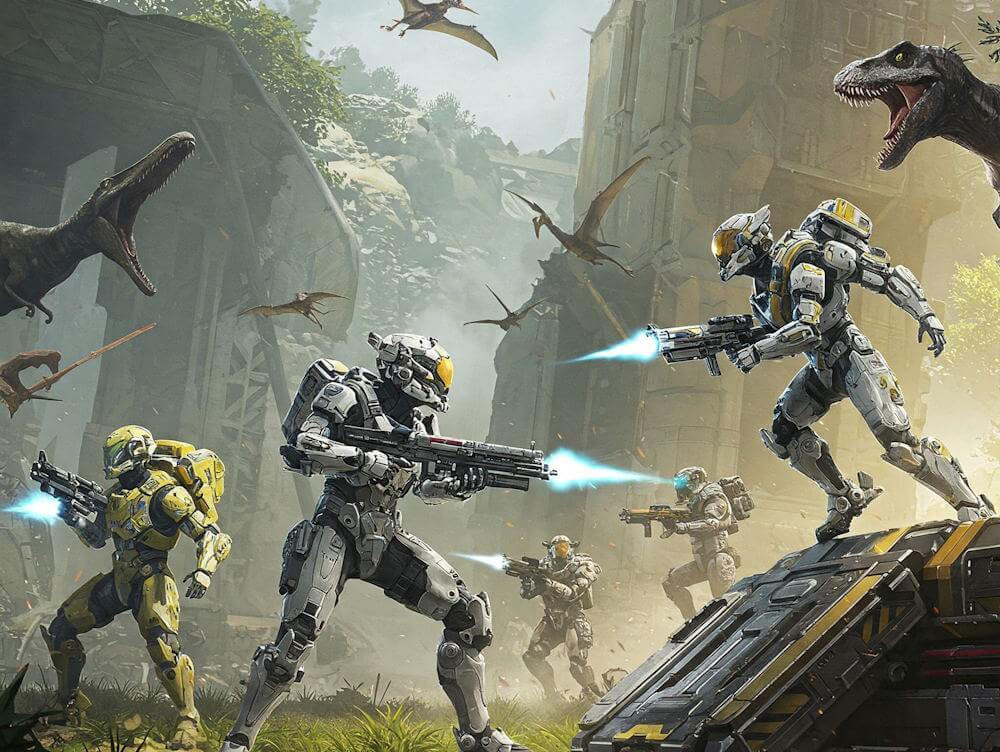Stray, an innovative video game developed by BlueTwelve Studio, made its highly anticipated debut on July 19, 2022. This adventure title captivates players by placing them in the role of a stray cat navigating a visually stunning cyberpunk city, filled with intricate environments and a vibrant atmosphere. Stray cleverly blends engaging storytelling with captivating gameplay mechanics, allowing players to experience life through the eyes of a feline protagonist.
The game unfolds in a dystopian world where humans have largely disappeared, leaving a society composed of sentient robots and neon-lit landscapes. As players take on the role of the titular stray cat, they must explore the vivid surroundings while solving puzzles, engaging with the enigmatic inhabitants, and uncovering hidden secrets of the city. The narrative invites players to delve deeper into this universe, evoking a sense of curiosity as they traverse through urban landscapes and interact with various robotic denizens.
One of the standout features of Stray is its unique gameplay mechanics. Players can utilize feline agility to navigate through rooftops, hide from adversaries, and interact with the environment. The controls are designed to mimic the fluidity and grace of a cat’s movement, enhancing the overall immersive experience. Additionally, Stray employs a rich visual design, featuring striking graphics that highlight the futuristic cityscape and create an engaging backdrop for players’ adventures.
In conclusion, Stray offers a refreshing perspective in gaming by presenting a narrative-driven adventure exclusively from the viewpoint of a stray cat. With its visually captivating world, innovative gameplay, and engaging storyline, it captures the hearts of players and invites them to explore a dystopian cyberpunk realm like never before.
The Unique Perspective of Playing as a Cat
The game “Stray” introduces players to an engaging experience by allowing them to embody a feline character in a vibrant, dystopian world. This innovative concept presents a fresh gameplay dynamic, elevating the immersion factor. Unlike traditional action-adventure titles, where players often control human characters with standard abilities, “Stray” capitalizes on the unique attributes of a cat, offering a distinctive perspective that redefines exploration and interaction within the game environment.
One of the primary advantages of playing as a cat is the agile movements that the character can perform. Players have the ability to leap gracefully across rooftops, navigate through narrow alleys, and stealthily evade threats. The fluid mechanics of movement mimic real-life feline agility, enabling players to experience a sense of freedom that is often absent in character-driven games. The thrill of chasing after a laser pointer or climbing up a series of ledges enhances the gameplay, making each traversal an exciting endeavor.
Moreover, the instincts of a cat—curiosity and playfulness—are beautifully interwoven into the game’s narrative. Players are encouraged to explore their surroundings thoroughly, as many hidden treasures and secrets can only be discovered through a cat’s inquisitive nature. This exploration fosters a deeper connection to the environment, allowing players to uncover the story and lore embedded within the vibrant world of “Stray.” Additionally, interactions with non-playable characters and objects are reflective of typical cat behavior, such as knocking items off surfaces or curling up for a nap, creating an authentic feeling of living as a cat.
This unique perspective enriches the overall gaming experience, providing an engaging way to navigate challenges while allowing players to connect with the world through a feline lens. As a result, “Stray” stands out in the gaming landscape, making players appreciate the subtleties of life through the eyes of a cat.
Exploring the Cyberpunk City
The world of “Stray” unfolds within a meticulously crafted cyberpunk city that serves as a playground for players who take on the role of a stray cat navigating its complexities. The aesthetic choices inherent in the cyberpunk genre are evident throughout the game, where neon lights juxtapose with the stark realities of a dystopian environment. This vibrant yet haunting city is not just a backdrop; it is an essential element that enhances the gameplay and enriches the narrative. The developers have painstakingly designed each area to reflect a narrative that is both engaging and immersive.
Players will find themselves exploring sprawling rooftops, narrow alleyways, and decaying industrial sectors, each filled with a plethora of secrets waiting to be uncovered. This urban landscape is alive with activity, showcasing various characters and interactive elements that invite players to delve deeper into the lore of the world. The presence of robotic inhabitants adds layers of depth and intrigue, as they represent remnants of a civilization that has evolved and devolved over time. Players are encouraged to observe, interact, and engage with their surroundings, revealing hidden areas and completing challenges that further enhance their journey.
The world-building of “Stray” not only serves to capture attention through its visual appeal but also facilitates a rich exploration experience. Each corner of this cyberpunk city offers new opportunities to engage with unique characters, solve puzzles, and discover hidden treasures. As players traverse the environment, they may feel a connection to the world that is both nostalgic and forward-thinking. This blend of exploration and rich urban storytelling ensures that each gameplay session feels fresh, as players continuously uncover layers of the city’s enigmatic past and present, heightening their overall experience and connection to the game.
Narrative and Storyline Overview
The narrative of Stray unfolds in a vibrant and meticulously crafted world where a stray cat becomes the unlikely hero. Set in a dystopian future inhabited by robotic beings, the story begins when the cat tumbles from its home in the bustling alleyways of a cyber city. As the protagonist, players embark on an immersive journey filled with exploration and discovery. Within this cat’s perspective, the storyline captures a sense of vulnerability and resilience, establishing an emotional connection with players right from the outset.
The main plot revolves around the cat’s quest to reunite with its family while unraveling the mysteries surrounding the robotic inhabitants and their environment. Along the way, the cat encounters a diverse array of characters, including a small drone companion named B12. This relationship adds depth to the narrative, as players witness the bond that develops between the cat and B12, illustrating themes of companionship and loyalty. As they navigate treacherous territories, evade threats, and solve puzzles, the storyline deepens, pulling players into the cat’s world.
Significant plot points include the cat’s discovery of abandoned districts, encounters with various robot factions, and the gradual unveiling of secrets that challenge the nature of existence within the city. Each interaction not only advances the plot but also layers rich emotional stakes, stirring empathy and investment in the characters’ journey. The world-building crafted by the developers enhances the storyline, making the robotic society feel alive with its unique culture and struggles. This compelling narrative structure is among the many reasons why Stray resonates profoundly with players, prompting a reflection on themes of belonging, survival, and connection in a world that often feels disconnected.
Gameplay Mechanics: Navigating and Interacting
The core gameplay mechanics of “Stray” not only allow players to navigate the urban environment but also immerse them in the unique experience of embodying a cat. Movement in the game is fluid and intuitive, reflecting the natural agility and grace of felines. Players utilize simple controls to leap onto rooftops, dash through narrow alleyways, and squeeze between obstacles. This design choice enhances the freedom of exploration, inviting players to traverse the captivating world at their own pace.
Puzzle-solving is a critical aspect of gameplay, often requiring players to engage with their surroundings to uncover secrets or overcome obstacles. As a cat, players can interact with various elements in the environment, such as knocking over objects, scratching surfaces, or pursuing small creatures. These interactions not only serve to solve puzzles but deepen the player’s connection to the game world, making the act of exploration both rewarding and enjoyable.
Moreover, the game’s emphasis on stealth introduces strategic gameplay elements that heighten the overall experience. As players navigate through various threats, including hostile creatures that populate the world, they must employ stealth tactics to avoid confrontation. Careful timing and choice of routes are essential, encouraging players to think critically about their surroundings. This adds a layer of tension and excitement that resonates with the game’s overarching themes of survival and vulnerability.
In sum, the integration of movement, puzzle-solving, and stealth mechanics in “Stray” creates a richly engaging experience. These gameplay elements not only facilitate exploration but also foster an emotional connection between the player and the feline protagonist. As players navigate this beautifully crafted world, they are consistently challenged to think creatively and strategically, ensuring that the game remains captivating throughout their adventure.
Environmental Storytelling and Visuals
The game Stray captivates not only through its gameplay but also through its exceptional environmental storytelling and visuals. Each aspect of the game’s design plays a crucial role in crafting a narrative that thrives on subtlety and visual cues rather than extensive dialogue. The world is drenched in rich colors, variably luminous lighting, and distinct architectural styles that evoke emotions, allowing players to immerse themselves organically into the feline protagonist’s journey.
Color usage within Stray is particularly striking; it serves to delineate different areas of the game while reflecting the underlying moods. The vibrant hues of the neon-lit shelters contrasted with the desaturated tones of abandoned alleyways effectively represent a sense of contrast and discovery. Each environment tells a story of its own, whether it be the remnants of a once-thriving civilization or a bustling robot community mirroring human society. Through these visuals, players experience companionship, solitude, and exploration intertwined with the narrative flow.
Furthermore, the game’s design—a meticulous blend of urban decay and futuristic elements—acts as a backdrop to the protagonist’s emotional experiences. Subtle details, such as scattered belongings and remnants of technology, provide narrative depth, giving context to the once-vibrant world. This strategy of storytelling fosters an intimate connection between the player and the environment, prompting players to ponder the lives of the beings who once inhabited these spaces.
The atmosphere in Stray is further enhanced by ambient sounds and visual fidelity, echoing life within the scenery. As a player navigates through the intricately crafted environments, the emotional weight of the visuals speaks volumes. Ultimately, the seamless integration of color, design, and atmosphere creates a compelling narrative that captures the essence of exploration and adventure—a hallmark of Stray’s enchanting storytelling approach.
Sound Design and Music
The sound design and music in Stray play a pivotal role in shaping the overall gaming experience, immersing players into a vivid, feline-centric world. The immersive atmosphere is achieved through meticulously crafted environmental sounds that allow players to feel the weight of their surroundings. Each area within the game is layered with unique audio elements, from the soft purring of cats to the distant hum of a futuristic city, creating an auditory landscape that resonates with the game’s themes of exploration and survival. The sound of rain pattering on surfaces evokes a sense of place, while subtle ambient noises contribute to a feeling of realism and depth.
The integration of sound effects is expertly executed, with each action eliciting a corresponding auditory reaction that enhances gameplay. For instance, the sound of the cat’s paws padding softly on various surfaces varies, allowing players to be acutely aware of their surroundings and enhancing their connection to the character. This attention to audio detail draws players deeper into the narrative, making them feel like an integral part of the unique world.
In addition to sound effects, the musical score in Stray significantly complements the emotional beats of the story. The soundtrack has been diligently crafted to resonate with the game’s various narrative arcs, accentuating moments of tension, joy, and melancholia alike. Whether it is a gentle melody that underscores a poignant scene or a more intense musical arrangement during moments of conflict, the score effectively enhances the emotional gravitas and urgency of the gameplay. In essence, the harmonious blend of sound design and music in Stray not only enriches the player experience but also serves to beautifully underscore the journey of the cat, making it a compelling adventure worth every moment spent within its captivating realm.
Community Reactions and Reviews
The release of “Stray,” a video game that allows players to embark on an adventure through the eyes of a stray cat, has evoked a wide range of reactions from both critics and the gaming community. The game, praised for its unique premise and engaging design, has cultivated a dedicated following. Many players have expressed their delight in the gameplay mechanics that successfully simulate the experiences of a feline, such as nimbly navigating urban environments and interacting with various NPCs (non-playable characters).
Critics have lauded “Stray” for its visually appealing graphics and intricately designed world. The game’s atmospheric soundtrack and sound design have also garnered appreciation, enhancing the player’s immersion in this vivid feline universe. Reviews frequently highlight how the game cleverly encapsulates the essence of a cat’s curiosity and independence. Players have shared their experiences of exploring the game’s richly detailed environments, creating an emotional connection with the stray cat protagonist. The narrative depth, which intertwines themes of companionship and loneliness, has resonated with many, marking it as a standout title of the year.
Conclusion: Why Stray is a Must-Play Experience
As we traverse through the vibrant, post-apocalyptic world of Stray, it becomes evident that this game offers a distinctive blend of curiosity, companionship, and discovery that resonates deeply with players. From the moment you step into the paw prints of the stray cat, you are not merely a bystander but an integral part of a heartfelt narrative that explores themes of loneliness amidst a bustling robotic society. The creative gameplay mechanics, such as seamlessly navigating the intricate environments and forming connections with the surrounding characters, invite players to engage more than just visually but emotionally as well.
One of the standout features of Stray is its ability to evoke a sense of wonder and intrigue. Through its beautifully designed landscapes, the game prompts players to explore every nook and cranny, fostering a spirit of curiosity that is both rewarding and fulfilling. As you uncover story fragments and piece together the backstory of this unique world, the act of discovery becomes an enriching experience that makes every moment spent in the game worthwhile. Such depth is rare in modern gaming, allowing Stray to carve out its niche in the hearts of its players.
Moreover, the aspect of companionship is poignantly illustrated through the bond you form with other characters, especially the adorable B12 companion. This relationship adds emotional weight and highlights the importance of connection, making it more than just a journey of survival; it evolves into a narrative about friendship and collaboration. For players looking for an experience that transcends mere entertainment, Stray not only provides engaging gameplay but also leaves a lasting impact through its storytelling.
In conclusion, Stray stands out as a must-play title, inviting gamers not only to partake in its captivating world but to also reflect on the beauties of companionship, curiosity, and exploration. We encourage readers to share their own experiences in Stray and how it resonated with them, fostering a community of fellow adventurers who appreciate the profound storytelling that games can offer.



